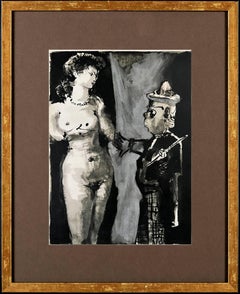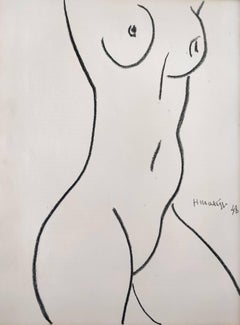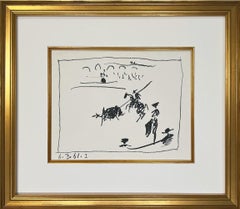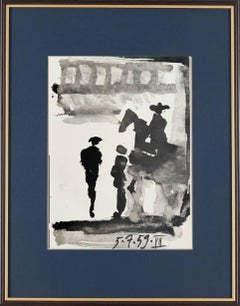Mid-20th Century More Prints
to
409
629
564
345
141
95
Overall Width
to
Overall Height
to
698
313
180
60
42
26
24
17
5
4
4
4
177
156
130
52
47
245
513
4,495
3,014
28
55
70
118
231
344
902
1,022
566
366
179
1,433
313
21
89
57
53
52
30
29
27
27
26
16
15
13
8
8
6
6
5
5
5
4
1,117
213
173
83
67
151
456
1,029
648
Period: Mid-20th Century
Le Peintre et son Modèle II
Located in OPOLE, PL
Pablo Picasso (1881-1973) - Le Peintre et son Modèle II
Lithograph from 1954.
Dimensions of work: 35.5 x 26.5 cm
Publisher: Tériade, Paris.
The work is in Excellent condition.
F...
Category
Modern Mid-20th Century More Prints
Materials
Lithograph
Femme Nu
Located in OPOLE, PL
Henri Matisse (1869-1954) - Femme Nu
Photogravure from 1952.
Dimensions of work: 35.5 x 26.4 cm
Publisher: Tériade, Paris.
The work is in Excellent condition.
Fast and secure sh...
Category
Surrealist Mid-20th Century More Prints
Materials
Photogravure
Düsseldorf (German Cities) by Dieter Roth monuments vintage postcard light blue
By Dieter Roth
Located in New York, NY
Düsseldorf (German Cities), 1970
24 x 33.8 in. / 61 x 86 cm
Screen print in one color on offset lithograph, black on white card. “for Paul” written in pencil lower middle. Signed and...
Category
Abstract Mid-20th Century More Prints
Materials
Lithograph, Screen
The Mythology Argus Color
Located in Hollywood, FL
ARTIST: Salvador Dali
TITLE: The Mythology Argus Color
MEDIUM: Etching
SIGNED: Hand Signed
PUBLISHER: Editions Argillet, Paris
EDITION NUMBER: XXX/L
MEASUREMENTS: 22.5" x 30.5...
Category
Surrealist Mid-20th Century More Prints
Materials
Etching
La Pique
Located in OPOLE, PL
Pablo Picasso (1881-1973) - La Pique
Lithograph from 1961.
Dimensions of work: 31 x 25 cm.
Reference: Bloch 1014; Cramer 113.IV.
Printed by Atelier Fernand Mourlot, Paris.
The wo...
Category
Modern Mid-20th Century More Prints
Materials
Lithograph
Don Quichote
Located in OPOLE, PL
Pablo Picasso (1881-1973) - Don Quichote
Lithograph with quadrochromy from 1961.
Dimensions of sheet: 37.9 x 27 cm
Dimensions in frame: 53.2 x 43.2 cm
Publisher: Éditions Cercle ...
Category
Modern Mid-20th Century More Prints
Materials
Lithograph
$658 Sale Price
20% Off
Femme nue
Located in OPOLE, PL
Pablo Picasso (1881-1973) - Femme nue
Lithograph, pochoir from 1962.
An unnumbered copy from a limited edition of 262.
Dimensions of work: 48.5 x 36 cm
Publisher: Leda, Éditions ...
Category
Modern Mid-20th Century More Prints
Materials
Lithograph
Mother and Child
Located in OPOLE, PL
Pablo Picasso (1881-1973) - Mother and Child
Lithograph from 1946.
Dimensions of work: 48 x 32.8 cm
Publisher: Pantheon.
The work is in Excellent condition.
Fast and secure shi...
Category
Modern Mid-20th Century More Prints
Materials
Lithograph
Don Quichote
Located in OPOLE, PL
Pablo Picasso (1881-1973) - Don Quichote
Lithograph with quadrochromy from 1961.
Dimensions of sheet: 37.9 x 27 cm
Dimensions in frame: 53.2 x 43.2 cm
Publisher: Éditions Cercle ...
Category
Modern Mid-20th Century More Prints
Materials
Lithograph
$658 Sale Price
20% Off
Peintre et modèle
Located in OPOLE, PL
Pablo Picasso (1881-1973) - Peintre et modèle
Lithograph from 1965.
Dimensions of work: 23 x 27 cm
Reference: Cramer 130
The work is in Excellent condition.
Fast and secure ship...
Category
Modern Mid-20th Century More Prints
Materials
Lithograph
$862 Sale Price
20% Off
Don Quichote
Located in OPOLE, PL
Pablo Picasso (1881-1973) - Don Quichote
Lithograph with quadrochromy from 1961.
Dimensions of sheet: 37.9 x 27 cm
Dimensions in frame: 53.2 x 43.2 cm
Publisher: Éditions Cercle ...
Category
Modern Mid-20th Century More Prints
Materials
Lithograph
Untitled, from ‘The International Association of Art Portfolio’
By Max Bill
Located in Llanbrynmair, GB
Untitled, from ‘The International Association of Art Portfolio’
By Max Bill
Medium - Screen print
Edition - 3/25
Signed - Yes
Size - 640mm x 460mm
Date...
Category
Abstract Mid-20th Century More Prints
Materials
Screen
$1,826 Sale Price
20% Off
Femme nue debout
Located in OPOLE, PL
Pablo Picasso (1881-1973) - Femme nue debout
Lithograph, pochoir from 1962.
An unnumbered copy from a limited edition of 267.
Dimensions of work: 48.5 x 36 cm
Publisher: Leda, Éd...
Category
Modern Mid-20th Century More Prints
Materials
Lithograph
Peintre et sa toile avec modèle assis
Located in OPOLE, PL
Pablo Picasso (1881-1973) - Peintre et sa toile avec modèle assis
Etching and aquatint from 1965.
The edition of 33/50.
Dimensions of work: 39 x 51.5 cm.
Hand signed.
Publisher:...
Category
Modern Mid-20th Century More Prints
Materials
Etching, Aquatint
$17,732 Sale Price
20% Off
Vintage French Fashion Poster
Located in London, GB
Vintage French fashion poster, original lithograph, by Jean Choiselat, (1947). Take a step back to the 1940s to immerse yourself in the surprising work ...
Category
Mid-20th Century More Prints
Materials
Lithograph
$442 Sale Price
20% Off
Minoutaure et nue
Located in OPOLE, PL
Pablo Picasso (1881-1973) - Minoutaure et nue
Lithograph from 1967.
The edition of 89/500 on Auvergne Richard de Bas paper.
With two watermarks - one of the paper, second of the p...
Category
Modern Mid-20th Century More Prints
Materials
Lithograph
La Comédie Humaine
Located in OPOLE, PL
Pablo Picasso (1881-1973) - La Comédie Humaine
Lithograph from 1954.
Dimensions of work: 35.5 x 26.5 cm
Publisher: Tériade, Paris.
The work is in Excellent condition.
Fast and s...
Category
Modern Mid-20th Century More Prints
Materials
Lithograph
After Picasso Exhibition Poster, "Mostra di Picasso, " depicting Guernica - 1953
Located in Roma, IT
Rare and giant vintage poster of Pablo Picasso Exhibition Milan, Palazzo Reale, 1953.
Limited edition of 1,000 copies, most of which lost or...
Category
Cubist Mid-20th Century More Prints
Materials
Offset
Table Before Window
Located in OPOLE, PL
Pablo Picasso (1881-1973) - Table Before Window
Lithograph from 1946.
Dimensions of work: 48 x 32.8 cm
Publisher: Pantheon.
The work is in Excellent condition.
Fast and secure ...
Category
Modern Mid-20th Century More Prints
Materials
Lithograph
'Pulitzer Fountain, Evening" — 1940s American Modernism, New York City
By Ellison Hoover
Located in Myrtle Beach, SC
Ellison Hoover, 'Pulitzer Fountain, Evening', lithograph, circa 1940, edition c. 40. Signed in pencil. A fine, atmospheric impression, on cream wove paper; the full sheet with margins (1 1/2 to 4 5/16 inches), in excellent condition. Archivally matted to museum standards, unframed.
Image size 12 1/2 x 9 5/8 inches (318 x 244 mm); sheet size 16 1/4 x 12 1/4 inches (413 x 311 mm).
ABOUT THE SUBJECT
The Pulitzer fountain was commissioned as a bequest by Joseph Pulitzer, newspaper publisher and founder of the Columbia School of Journalism. Designed by Austrian sculptor Karl Bitter...
Category
American Modern Mid-20th Century More Prints
Materials
Lithograph
$1,760 Sale Price
20% Off
Mi Careme de Nantes original vintage French poster
Located in Spokane, WA
Original vintage French poster: Mi Careme de Nantes carnaval poster. Printer: Jagueneau - Nantes, France.
Over 50 years old, Linen ...
Category
Modern Mid-20th Century More Prints
Materials
Lithograph
$340 Sale Price
20% Off
The Anointing of Saul
By Marc Chagall
Located in OPOLE, PL
Marc Chagall (1887-1985) - The Anointing of Saul
Etching from 1952.
Edition of 100
Enhanced with watercolour by the artist.
Dimensions of work: 52 x 37 cm.
Hand signed.
Publish...
Category
Modern Mid-20th Century More Prints
Materials
Etching
$5,252 Sale Price
20% Off
Original "Stocks Americains" vintage French poster horizontal format
Located in Spokane, WA
Original “Stocks Americans” vintage poster. Linen backed in very good condition, ready to frame. No paper loss, no fold marks, clean and bright. Distress on one letter “S” in A...
Category
American Impressionist Mid-20th Century More Prints
Materials
Lithograph
$558 Sale Price
20% Off
Original Fly TWA India vintage travel poster David Klein
By David Klein
Located in Spokane, WA
Original Fly TWA India vintage travel poster. Artist: David Klein. Archival linen backed in very fine condition, ready to frame.
This poster features a...
Category
American Modern Mid-20th Century More Prints
Materials
Offset
Hero as a Riddle by Eduardo Paolozzi gold silver pop art with Basquiat style
Located in New York, NY
Hero as a Riddle (1963) depicts a smiling head printed in gold, silver, and black. The shapes and lines composing the figure’s face are architectural and geometric: the eyes are comp...
Category
Pop Art Mid-20th Century More Prints
Materials
Screen
Rubin from Album Lapidaire - Op Art
Located in London, GB
Victor Vasarely (Hungarian/French, 1906-1997)
Rubin, 1964
Screenprint in Colours
from the Lapidaire portfolio
signed in pencil lower right with blind stamp, numbered edition "41/15...
Category
Op Art Mid-20th Century More Prints
Materials
Screen
Animam et Corpus Trado pro Patriis Legibus - Lithograph - 1964
Located in Roma, IT
Animam et Corpus Trado pro Patriis Legibus is a Color lithograph on heavy rag paper realized in 1964. It is part of Biblia Sacra vulgatæ edition is published by Rizzoli-Mediolani bet...
Category
Surrealist Mid-20th Century More Prints
Materials
Lithograph
Portrait of a Lady
Located in OPOLE, PL
Pablo Picasso (1881-1973) - Portrait of a Lady
Lithograph from 1946.
Dimensions of work: 48 x 32.8 cm
Publisher: Pantheon.
The work is in Excellent condition.
Fast and secure sh...
Category
Modern Mid-20th Century More Prints
Materials
Lithograph
Jeu de la Cape
Located in OPOLE, PL
Pablo Picasso (1881-1973) - Jeu de la Cape
Lithograph from 1961.
Dimensions of work: 31 x 25 cm.
Reference: Bloch 1015; Mourlot 350; Cramer 113.IV.
Printed by Atelier Fernand Mour...
Category
Modern Mid-20th Century More Prints
Materials
Lithograph
Portrait de Jacqueline
Located in OPOLE, PL
Pablo Picasso (1881-1973) - Portrait de Jacqueline
Lithograph from 1967.
The edition of 29/500 on Auvergne Richard de Bas paper.
With two watermarks - one of the paper, second of ...
Category
Modern Mid-20th Century More Prints
Materials
Lithograph
$2,387 Sale Price
20% Off
Dans L'Atelier de Picasso
Located in OPOLE, PL
Pablo Picasso (1881-1973) - Dans l'Atelier de Picasso
Lithograph from 1957.
The edition 211/275.
Dimensions of work: 44.5 x 33.5 cm
Publisher: Fernand Mourlot Éditeur, Paris.
Re...
Category
Modern Mid-20th Century More Prints
Materials
Lithograph
$2,387 Sale Price
20% Off
La Pique (I), from A Los Toros Avec Picasso
Located in Washington, DC
Artist: Pablo Picasso
Title: La Pique (I)
Portfolio: A Los Toros Avec Picasso
Medium: Transfer lithograph
Date: 1961
Frame Size: 17 1/4" x 19 3/4"
Sheet Size: 9 1/2" x 12 1/2"
Image ...
Category
Abstract Mid-20th Century More Prints
Materials
Lithograph
Pablo Picasso, La Petite Corrida, lithograph
Located in Chatsworth, CA
This piece is a lithograph in colors (after)Pablo Picasso, done in 1957. Picasso created this piece for the special issue of the art publication XXe Sicle Review No. 10, entitled "Ho...
Category
Modern Mid-20th Century More Prints
Materials
Lithograph
Jeu de la Cape (III), from A Los Toros Avec Picasso
Located in Washington, DC
Artist: Pablo Picasso
Title: Jeu de la Cape (III)
Portfolio: A Los Toros Avec Picasso
Medium: Transfer lithograph
Date: 1961
Edition: Unnumbered
Frame Size: 17 1/4" x 19 3/4"
Sheet S...
Category
Abstract Mid-20th Century More Prints
Materials
Lithograph
Pedro Casals San Juan Puerto Rico vintage poster
Located in Wilton Manors, FL
Lorenzo Homar
Casals Poster, 1966.
Lithograph, 19 x 29 inches.
Some wear as can be observed in detail photos.
Category
Modern Mid-20th Century More Prints
Materials
Lithograph
Femme Bleue
Located in OPOLE, PL
Henri Matisse (1869-1954) - Femme Bleue
Lithograph from 1958.
Dimensions of work: 35.5 x 26.4 cm.
Publisher: Tériade, Paris.
First, original edition.
The work is in Excellent co...
Category
Surrealist Mid-20th Century More Prints
Materials
Lithograph
$862 Sale Price
20% Off
Nu assis
Located in OPOLE, PL
Pablo Picasso (1881-1973) - Nu assis
Lithograph, pochoir from 1962.
An unnumbered copy from a limited edition of 268.
Dimensions of work: 48.5 x 36 cm
Publisher: Leda, Éditions d...
Category
Modern Mid-20th Century More Prints
Materials
Lithograph
Jacqueline
Located in OPOLE, PL
Pablo Picasso (1881-1973) - Jacqueline
Lithograph with quadrochromy from 1961.
Dimensions of sheet: 37.9 x 27 cm
Dimensions in frame: 53.2 x 43.2 cm
Publisher: Éditions Cercle d'...
Category
Modern Mid-20th Century More Prints
Materials
Lithograph
Matadores
Located in OPOLE, PL
Pablo Picasso (1881-1973) - Matadores
Lithograph with quadrochromy from 1961.
Dimensions of sheet: 37.9 x 27 cm
Dimensions in frame: 53.2 x 43.2 cm
Publisher: Éditions Cercle d'A...
Category
Modern Mid-20th Century More Prints
Materials
Lithograph
$658 Sale Price
20% Off
Le Picador
Located in OPOLE, PL
Pablo Picasso (1881-1973) - Picador II
Lithograph from 1961.
Dimensions of work: 31 x 25 cm.
Reference: Bloch 1017; Mourlot 350; Cramer 113.IV.
Printed by Atelier Fernand Mourlot, P...
Category
Modern Mid-20th Century More Prints
Materials
Lithograph
Matadores
Located in OPOLE, PL
Pablo Picasso (1881-1973) - Matadores
Lithograph with quadrochromy from 1961.
Dimensions of sheet: 37.9 x 27 cm
Dimensions in frame: 53.2 x 43.2 cm
Publisher: Éditions Cercle d'A...
Category
Modern Mid-20th Century More Prints
Materials
Lithograph
Portrait de Jacqueline
Located in OPOLE, PL
Pablo Picasso (1881-1973) - Portrait de Jacqueline
Lithograph from 1967.
The edition of 223/500 on Auvergne Richard de Bas paper.
With two watermarks - one of the paper, second of...
Category
Modern Mid-20th Century More Prints
Materials
Lithograph
$1,821 Sale Price
20% Off
Marc Chagall - Opera
By Marc Chagall
Located in OPOLE, PL
Marc Chagall (1887-1985) - Opera
Lithograph from 1965.
Dimensions of work: 32 x 23.5 cm.
Publisher: André Sauret, Monte Carlo.
The work is in Excellent condition.
Category
Abstract Mid-20th Century More Prints
Materials
Lithograph
$859 Sale Price
20% Off
Portraits Imaginaires 27.2.69 I
Located in OPOLE, PL
Pablo Picasso (1881-1973) - Portraits Imaginaires 27.2.69 I
Lithograph from 1969.
The edition: F 108/250.
Dimensions of work: 64 x 49 cm.
Plate signed.
The work is in Excellent ...
Category
Modern Mid-20th Century More Prints
Materials
Lithograph
$6,207 Sale Price
20% Off
Los Banderillos
Located in OPOLE, PL
Pablo Picasso (1881-1973) - Los Banderillos
Lithograph from 1961.
Dimensions of work: 31 x 25 cm.
Reference: Bloch 1016; Cramer 113.IV.
Printed by Atelier Fernand Mourlot, Paris.
...
Category
Modern Mid-20th Century More Prints
Materials
Lithograph
Fleurs de Neige
Located in OPOLE, PL
Henri Matisse (1869-1954) - Fleurs de Neige
Lithograph from 1958.
Dimensions of work: 35.5 x 26.4 cm
Plate signed.
Publisher: Tériade, Paris.
First, original edition.
The work ...
Category
Surrealist Mid-20th Century More Prints
Materials
Lithograph
$859 Sale Price
20% Off
Don Quichote
Located in OPOLE, PL
Pablo Picasso (1881-1973) - Don Quichote
Lithograph with quadrochromy from 1961.
Dimensions of sheet: 37.9 x 27 cm
Dimensions in frame: 53.2 x 43.2 cm
Publisher: Éditions Cercle ...
Category
Modern Mid-20th Century More Prints
Materials
Lithograph
Lierre
Located in OPOLE, PL
Henri Matisse (1869-1954) - Lierre
Lithograph from 1958.
Dimensions of work: 35.5 x 26.4 cm
Plate signed.
Publisher: Tériade, Paris.
First, original edition.
The work is in Exc...
Category
Surrealist Mid-20th Century More Prints
Materials
Lithograph
$859 Sale Price
20% Off
Iesus a Satana Tentatur - Lithograph - 1964
Located in Roma, IT
Iesus a Satana tentatur ("Jesus temptet by Satan") is an artwork realized in 1964. It is part of Biblia Sacra vulgatæ editionis published by Rizzoli-Mediolani between 1967 and 1969. ...
Category
Surrealist Mid-20th Century More Prints
Materials
Lithograph
$447 Sale Price
25% Off
Les Peintres Temoins et Leurs Temps (before lettering) by Marc Chagall
By Marc Chagall
Located in New York, NY
This lithograph was printed in 1963 at the Atelier Mourlot in Paris. This print was executed for the annual exhibition "Les Peintres Temoins de Leur Temps" at the Galleria museum in ...
Category
Mid-20th Century More Prints
Materials
Lithograph
Atelier Mourlot - New York (NYC Skyline) by Bernard Buffet
Located in New York, NY
Arches Poster Paper - Perfect Condition A+
When The Mourlot Studio opened a branch in New York City, after a successful exhibition organized by the Smithsonian Institute in 1963, it...
Category
Modern Mid-20th Century More Prints
Materials
Lithograph
Quarry
Located in Washington, DC
Artist: Robert Rauschenberg
Title: Quarry
Medium: Offset lithograph in colors
Year: 1968
Edition: 500
Frame Size: 41 1/2" x 33"
Sheet Size: 35 1/2" x 26 1/2"
Signature: Signed in the...
Category
Pop Art Mid-20th Century More Prints
Materials
Lithograph
Minotaure
Located in OPOLE, PL
Pablo Picasso (1881-1973) - Minotaure
Lithograph from 1967.
The edition of 223/500 on Auvergne Richard de Bas paper.
With two watermarks - one of the paper, second of the publishe...
Category
Modern Mid-20th Century More Prints
Materials
Lithograph
Seattle United Air Lines original vintage travel poster
Located in Spokane, WA
Original excellent condition, linen backed United Airlines: Seattle, the 1968 airplane airline aviation travel poster promoting travel to Seattle, Washington aboard United Airlines and featuring art of a Native American Indian totem pole...
Category
American Modern Mid-20th Century More Prints
Materials
Offset
Sweet Carburetor, from Series II
By Gene Davis
Located in Washington, DC
Artist: Gene Davis
Title: Sweet Carburetor
Portfolio: Series II
Medium: Screenprint on canvas laminated to board
Year: 1969
Edition: 110/150
Frame Size: 36 1/2" x 26 1/2"
Sheet Size:...
Category
Abstract Mid-20th Century More Prints
Materials
Screen
Femme Bleue
Located in OPOLE, PL
Henri Matisse (1869-1954) - Femme Bleue
Lithograph from 1958.
Dimensions of work: 35.5 x 26.4 cm
Publisher: Tériade, Paris.
First, original edition.
The work is in Excellent con...
Category
Surrealist Mid-20th Century More Prints
Materials
Lithograph
Figure
Located in OPOLE, PL
Pablo Picasso (1881-1973) - Figure
Lithograph from 1957.
The edition no. 211/275.
With Arches watermark.
Dimensions of work: 44.5 x 33.5 cm.
Publisher: Fernand Mourlot Éditeur, ...
Category
Modern Mid-20th Century More Prints
Materials
Lithograph
$1,432 Sale Price
20% Off
Historic Leo Castelli Gallery print, hand signed & dated by Frank Stella, Framed
By Frank Stella
Located in New York, NY
Frank Stella at Leo Castelli (Hand Signed and Dated), 1969
Offset Lithograph Invitation
Boldly signed and dated 2014 in black marker; Stella signed this f...
Category
Abstract Geometric Mid-20th Century More Prints
Materials
Lithograph, Offset
'Fougasse', The Indispensables - Official Rugby Union Publications Poster
Located in London, GB
To see our other original vintage public information posters, scroll down to "More from this Seller" and below it click on "See all from this seller" - or send us a message if you cannot find the poster you want.
Cyril Kenneth Bird ‘Fougasse’ (1887 - 1965)
The Indispensables
Lithographic poster
30 x 22 cm
Fougasse was a British cartoonist. He was art editor of Punch between 1937 and 1949, and subsequently editor until 1953. He is best known for his ‘Careless Talk Costs Lives’ series of posters, and the other posters for the Ministry of Information and London Transport.
As the Second World War progressed, the Ministry of Information’s poster campaign had become less and less effective. There were posters instructing the population to save old clothes for rags, turn off the lights, save food, dig for victory...
Category
Modern Mid-20th Century More Prints
Materials
Lithograph
Mascara Roja
Located in San Francisco, CA
This artwork titled "Mascara Roja" 1969 is an original colors lithograph on B.F.K. Rives paper by renown Mexican artist Rufino Tamayo, 1899-1991. It is hand signed and inscribed H.C. (Hors Commerce) in pencil by the artist. The image size is 21 x 27.25 inches, framed size is 37.25 x 42 inches. Published by Touchtone Publisher, New York, printed by Ateliers Desjobert, Paris. Referenced and pictured in the artist's catalogue raisonne by Pereda, plate #124. Custom framed in a wooden gold leaf frame, with gold and red spacer and fabric matting. It is in excellent condition.
About the artist:
A native of Oaxaca in Southern Mexico, Rufino Tamayo's father was a shoemaker, and his mother a seamstress. Some accounts state that he was descended from Zapotec Indians, but he was actually 'mestizo' - of mixed indigenous/European ancestry. (Santa Barbara Museum of Art). He began painting at age 11. Orphaned at the age of 12, Tamayo moved to Mexico City, where he was raised by his maternal aunt who owned a wholesale fruit business.
In 1917, he entered the San Carlos Academy of Fine Arts, but left soon after to pursue independent study. Four years later, Tamayo was appointed the head designer of the department of ethnographic drawings at the National Museum of Archaeology in Mexico City. There he was surrounded by pre-Colombian objects, an aesthetic inspiration that would play a pivotal role in his life. In his own work, Tamayo integrated the forms and tones of pre-Columbian ceramics into his early still lives and portraits of Mexican men and women.
In the early 1920s he also taught art classes in Mexico City's public schools. Despite his involvement in Mexican history, he did not subscribe to the idea of art as nationalistic propaganda. Modern Mexican art at that time was dominated by 'The Three Great Ones' : Diego Rivera, Jose Clemente Orozco, and David Alfaro Siqueros, but Tamayo began to be noted as someone 'new' and different' for his blending of the aesthetics of post Revolutionary Mexico with the vanguard artists of Europe and the United States.
After the Mexican Revolution, he focused on creating his own identity in his work, expressing what he thought was the traditional Mexico, and refusing to follow the political trends of his contemporary artists. This caused some to see him as a 'traitor' to the political cause, and he felt it difficult to freely express himself in his art. As a result, he decided to leave Mexico in 1926 and move to New York, along with his friend, the composer Carlos Chavez. The first exhibition of Tamayo's work in the United States was held at the Weyhe Gallery, New York, in that same year. The show was successful, and Tamayo was praised for his 'authentic' status as a Mexican of 'indigenous heritage', and for his internationally appealing Modernist aesthetic. (Santa Barbara Museum of Art).
Throughout the late thirties and early forties New York's Valentine Gallery gave him shows. For nine years, beginning in 1938, he taught at the Dalton School in New York.
In 1929, some health problems led him to return to Mexico for treatment. While there he took a series of teaching jobs. During this period he became romantically involved with the artist Maria Izquierdo...
Category
Modern Mid-20th Century More Prints
Materials
Lithograph



